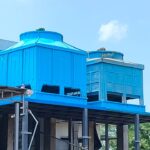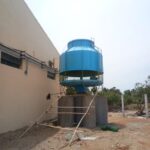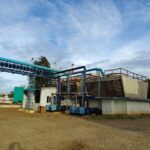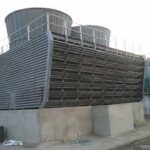Evaporative Cooling Tower
Evaporative cooling tower are devices used to remove excess heat from industrial processes, power plants, and HVAC systems by using the principle of water evaporation. As hot water from the system is distributed over fill media inside the tower, air is simultaneously drawn or pushed through the tower, causing a portion of the water to evaporate. This evaporation process absorbs heat, effectively cooling the remaining water, which is then recirculated back into the system.

Evaporative Cooling Tower
Importance in
Energy Efficiency
- Reduced Energy Consumption: Evaporative cooling towers use the natural process of water evaporation to dissipate heat, which consumes significantly less energy compared to air-cooled systems.
- Cost Savings: The lower energy consumption translates into reduced operational costs, making it a cost-effective solution for large-scale cooling needs.
High Cooling Capacity
- Effective Heat Dissipation: Capable of dissipating large amounts of heat, making them ideal for industrial processes, power plants, and large HVAC systems.
- Adaptability: Can handle varying cooling loads and are effective even in high ambient temperature conditions, providing reliable cooling performance.
Scalability and Flexibility
- Modular Designs: Can be scaled up or down based on the cooling requirements, making them suitable for both small and large facilities.
- Customizable Solutions: Can be designed to fit specific operational needs and space constraints, providing tailored cooling solutions.
Environmental Benefits
- Lower Carbon Footprint: By consuming less energy, cooling towers help reduce greenhouse gas emissions associated with electricity production.
- Water Conservation: Modern cooling towers are designed to recycle water within the system, minimizing water waste and promoting sustainability.
Evaporative Cooling Tower
Specification Details
| Type | Description | Applications | Key Features |
|---|---|---|---|
| Natural Draft | Uses natural convection to induce airflow through the cooling tower. | Large-scale power plants | Energy-efficient, large structures |
| Mechanical Draft | Uses mechanical fans to enhance airflow. | Industrial, HVAC | Includes induced and forced draft |
| Crossflow | Air flows horizontally across the fill while water flows vertically. | HVAC, light industrial | Easy maintenance, low pumping head |
| Counterflow | Air flows vertically upward while water flows downward through the fill. | Various industrial and HVAC | Efficient heat transfer, compact |
| Hybrid | Combines wet and dry cooling techniques. | Regions with water scarcity | Reduced water usage, flexible |
| Closed Circuit (Fluid Coolers) | Process fluid circulates through a closed loop cooled by an external water circuit. | HVAC, industrial processes | Prevents contamination, clean fluid |
| Modular | Consists of multiple small units for scalability. | Facilities with changing demands | Easy to expand, flexible |
Evaporative Cooling Towers
Basic Working Concepts
Hot Water Entry
- Hot water from the system enters the cooling tower through an inlet pipe.
- The water is typically distributed to the top of the cooling tower.
Hot water entry
The water entering the tower is heated by the industrial process or system it is cooling, carrying a significant amount of heat energy that needs to be dissipated.
Air Flow
- Air is drawn into the cooling tower through air inlets by fans (mechanical draft) or through natural convection (natural draft).
- The air flows across or counter to the falling water, picking up moisture and heat.
Air Flow
Air movement is essential for evaporation. In mechanical draft towers, fans enhance airflow, while in natural draft towers, temperature differences create airflow.
Evaporation and Cooling
- As the air moves through the fill media, a small portion of the water evaporates.
- Evaporation absorbs heat from the remaining water, cooling it down.
Evaporation and Cooling
The heat required for evaporation is taken from the water itself, which reduces the temperature of the remaining water.
Fill Media
- The fill media, typically made of plastic or wood, increases the surface area of the water.
- Water spreads into thin films or droplets as it trickles down through the fill media.
Fill media
The large surface area provided by the fill media promotes efficient heat transfer from the water to the air.
Other Cooling Towers We Manufacturer
Square Type Cooling Tower
Square Type Cooling Tower functions on the principle of induced draft counter flow operation. The fan generates vertical air movement that flows upwards on the tower and across the fills, opposing the water flow.

Round Type Cooling Tower
The Round Type Cooling Tower, constructed from FRP, boasts resistance to corrosion, resilience against extreme vibrations, and the ability to withstand high wind loads. Its design emphasizes efficiency

Wooden Cooling Tower
Wooden Cooling Tower are designed to handle water with high levels of dissolved solids (TDS). Hot water from the source is sprayed over special nozzles in a collection basin

Closed Circuit Cooling Tower
Closed Circuit Cooling Tower is a type of heat exchanger that combines the functions of a cooling tower and a heat exchanger in a single unit.

Cross Flow Cooling Tower
Cross flow cooling towers is a cooling system where air flows horizontally through the tower while water flows vertically downward.

Dry Cooling Tower
Dry Cooling Towers is a type of cooling system used in industrial and power generation processes to remove excess heat

Natural Draft Cooling Tower
Natural draft cooling towers are a type of cooling tower that uses the natural convection of air to cool water.

Cooling Towers We Exported to
Cooling Towers We Export to Northern Province
Cooling Towers We Export to Perak
Cooling Towers We Export to Poland
Cooling Towers We Export to Portugal
Cooling Towers We Export to Qatar
Cooling Towers We Export to Rangpur
Cooling Towers We Export to Romania
Cooling Towers We Export to Russia
Heat Exchangers We Exported to
Heat Exchangers We Export to Fukushima
Heat Exchangers We Export to Gansu
Heat Exchangers We Export to Georgia
Heat Exchangers We Export to Germany
Heat Exchangers We Export to Gifu
Heat Exchangers We Export to Gilgit-Baltistan
Heat Exchangers We Export to Grand Est
Heat Exchangers We Export to Greece
Industrial Chiller We Exported to
Industrial Chiller We Export to Portugal
Industrial Chiller We Export to Qatar
Industrial Chiller We Export to Rajshahi
Industrial Chiller We Export to Rangpur
Industrial Chiller We Export to Ras Al Khaimah
Industrial Chiller We Export to Romania
Industrial Chiller We Export to Russia
Industrial Chiller We Export to Sabah
